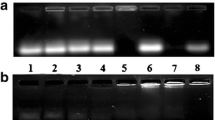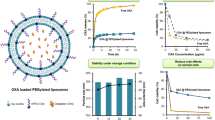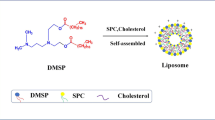Abstract
Phosphatidylcholine–sodium cholate (SC)-based nanoparticles were designed, characterized, and evaluated as plausible oligonucleotides delivery systems. For this purpose, formulation of the systems was optimized to obtain low cytotoxic vehicles with high siRNA-loading capacity and acceptable transfection ability. Mixtures of soybean phosphatidylcholine (SPC) and SC were prepared at different molar ratios with 2 % w/v total concentration; distilled water and two different buffers were used as dispersion medium. Nanoparticles below 150 nm were observed showing spherical shape which turned smaller in diameter as the SC molar proportion increased, accounting for small unilamellar vesicles when low proportions of SC were present in the formulation, but clear mixed micellar solutions at higher SC percentages. Macroscopic characteristics along with physico-chemical parameters values supported the presence of these types of structures. SYBR green displacement assays demonstrated an important oligonucleotide binding that increased as bile salt relative content got higher. Within the same molar ratio, nanoparticles showed the following binding efficiency order: pH 7.4 > pH 5.0 > distilled water. siRNA-loading capacity assays confirmed the higher siRNA binding by the mixed micelles containing higher SC proportion; moreover, the complexes formed were smaller as the SC:SPC ratio increased. Considering cytotoxicity and siRNA-loading capacity, 1:2 and 1:4 SPC:SC formulations were selected for further biological assays. Nanoparticles prepared in any of the three media were able to induce dsRNA uptake and efficiently transfect RNA for gene silencing, for the compositions prepared in buffer pH 5.0 being the most versatile.








Similar content being viewed by others
References
Barenholz Y (2012) Doxil®—The first FDA-approved nano-drug: lessons learned. J Control Release 160:117–134
Bosselmann S, Williams RO (2012) Has nanotechnology led to improved therapeutic outcomes? Drug Dev Ind Pharm 38:158–170
Cabral DJ, Hamilton JA, Small DM (1986) The ionization behavior of bile acids in different aqueous environments. J Lipid Res 27:334–344
Chen H, Guo Z, Yu F, Ki J et al (2008) Influence of La3+ ions on the egg-yolk phosphatidylcholine and sodium taurocholate self-assemblies in aqueous suspension. J Colloid Interface Sci 328:158–165
Cukierman E, Khan DR (2010) The benefits and challenges associated with the use of drug delivery systems in cancer therapy. Biochem Pharmacol 80:762–770
Dangi JS, Vyas SP, Dixit VK (1998) Effect of various lipid-bile salt mixed micelles on the intestinal absorption of Amphotericin-B in rat. Drug Dev Ind Pharm 24(7):631–635
de Fougerolles A, Vornlocher HP, Maraganore J, Lieberman J (2007) Interfering with disease: a progress report on siRNA-based therapeutics. Nat Rev Drug Discov 6(6):443–453
Dokka S, Toledo D, Shi X, Castranova V, Rojanasakul Y (2000) Oxygen radical-mediated pulmonary toxicity induced by some cationic liposomes. Pharm Res 17:521–525
Dorasamy S, Moganavelli S, Ariatti M (2009) Rapid and sensitive fluorometric analysis of novel galactosylated cationic liposome interaction with siRNA. Afr J Pharm Pharmacol 3:632–635
Dürr M, Hager J, Lohr JP (1994) Investigation on mixed micelle and liposome preparations for parenteral use based on soya phosphatidylcholine. Eur J Pharm Biopharm 40:147–156
Fisher TL, Terhorst T, Cao X, Wagner RW (1993) Intracellular disposition and metabolism of fluorescently-labeled unmodified and modified oligonucleotides microinjected into mammalian cells. Nucleic Acids Res 21:3857–3865
Gándola Y, Pérez SE, Irene PE, Sotelo AI, Miquet JG, Corradi GR, Carlucci AM, González L (2014) Mitogenic effects of phosphatidylcholine nanoparticles on MCF-7 breast cancer cells. Biomed Res Int. Vol 2014, Article ID 687037, p 13. doi: 10.1155/2014/687037
Geall AJ, Blagbrough IS (2000) Rapid and sensitive ethidium bromide fluorescence quenching assay of polyamine conjugate-DNA interactions for the analysis of lipoplex formation in gene therapy. J Pharm Biomed Anal 22:849–859
Gomes-da-Silva LC, Fonseca NA, Moura V, Pedroso de Lima MC, Simões S, Moreira JN (2012) Lipid-based nanoparticles for siRNA delivery in cancer therapy: paradigms and challenges. Acc Chem Res 45(7):1163–1171. doi:10.1021/ar300048p
Gooding M, Browne LP, Quinteiro FM, Selwood DL (2012) siRNA delivery: from lipids to cell-penetrating peptides and their mimics. Chem Biol Drug Des 80:787–809
Grobmyera SR, Zhoua G, Gutweina LG, Iwakumab N, Sharmac P, Hochwald SN (2012) Nanoparticle delivery for metastatic breast cancer. Nanomedicine 8:S21–S30
Günther M, Lipka J, Malek A, Gutsch D, Kreyling W et al (2011) Polyethylenimines for RNAi-mediated gene targeting in vivo and siRNA delivery to the lung. Eur J Pharm Biopharm 77:438–449
Guo X, Huang L (2012) Recent advances in nonviral vectors for gene delivery. Acc Chem Res 45(7):971–979. doi:10.1021/ar200151m
Hammad MA, Müller BW (1998) Increasing drug solubility by means of bile salt–phosphatidylcholine-based mixed micelles. Eur J Pharm Biopharm 46(3):361–367
Hendradi E, Obata Y, Takayama K, Nagai T (2003) Effect of bile salts-lecithin mixed micelles on the skin permeation of diclofenac in rats. STP Pharm Sci 13(4):247–251
Judge AD, Robbins M, Tavakoli I, Levi J, Hu L et al (2009) Confirming the RNAi-mediated mechanism of action of siRNA-based cancer therapeutics in mice. J Clin Invest 119(3):661–673
Kapoor M, Burgess DJ, Patil SD (2012) Physicochemical characterization techniques for lipid based delivery systems for siRNA. Int J Pharm 427:35–57
Katas H, Oya Alpar H (2006) Development and characterization of chitosan nanoparticles for siRNA delivery. J Control Release 115(2):216–225
Khurana B, Goyal AK, Budhiraja A, Arora D, Vyas SP (2010) siRNA delivery using nanocarriers—an efficient tool for gene silencing. Curr Gene Ther 10(2):139–155
Lammers T, Kiessling F, Hennink WE, Storm G (2012) Drug targeting to tumors: principles, pitfalls and (pre-) clinical progress. J Control Release 161:175–187
Lemke TL (2008) Pharmaceutical biotechnology: from nucleic acids to personalized medicine. In: (ed) Foye’s principles of medicinal chemistry, 6th edn. Lippincott Williams & Wilkins, Philadelphia, pp 115–175
Lv H, Zhang S, Wang B, Cui S, Yan J (2006) Toxicity of cationic lipids and cationic polymers in gene delivery. J Control Release 114(1):100–109
Manjunath N, Dykxhoorn DM (2010) Advances in synthetic siRNA delivery. Discov Med 9(48):418–430
Monteagudo E, Gándola Y, González L, Bregni C, Carlucci A (2012) Development, characterization and in vitro evaluation of tamoxifen microemulsions. J Drug Deliv. Vol 2012, Article ID 236713, p 11. doi:10.1155/2012/236713
Müller K (1981) Structural dimorphism of bile salt/lecithin mixed micelles. A possible regulatory mechanism for cholesterol solubility in bile? X-ray structure analysis. Biochemistry 20:404–414
Naik S, Chougule M, Padhi BK, Misra A (2005) Development of novel lyophilized mixed micelle amphotericin B formulation for treatment of systemic fungal infection. Curr Drug Deliv 2(2):177–184
Nishikawa M, Huang L (2001) Nonviral vectors in the new millennium: delivery barriers in gene transfer. Hum Gene Ther 12(8):861–870
Omedes Pujol M, Coleman DJL, Allen CD, Heidenreich O, Fulton DA (2013) Determination of key structre-activity relationships in siRNA delivery with a mixed micelle system. J Control Release 172(3):939–945
Ozpolat B, Sood AK, Lopez-Berestein G (2010) Nanomedicine based approaches for the delivery of siRNA in cancer. J Intern Med 267(1):44–53
Modi P (2000) Mixed micellar delivery system and method of preparation. US Patent 6017545 A, 25 January 2000
Pérez SE, Gándola Y, Carlucci AM, González L, Turyn D, Bregni C (2012) Formulation strategies, characterization, and in vitro evaluation of lecithin-based nanoparticles for siRNA delivery. J Drug Deliv. Vol 2012, Article ID 986265, p 9, doi:10.1155/2012/986265
Schroeder A, Levins CG, Cortez C, Langer R, Anderson DG (2010) Lipid-based nanotherapeutics for siRNA delivery. J Intern Med 267(1):9–21
Shim MS, Kwon YJ (2010) Efficient and targeted delivery of siRNA in vivo. FEBS J 277(23):4814–4827
Smidt JH, Grit M, Crommelin DJA (1994) Dissolution kinetics of griseofulvin in mixed micellar solutions. J Pharm Sci 83:1209–1212
Spagnou S, Miller AD, Keller M (2004) Lipidic carriers of siRNA: differences in the formulation, cellular uptake, and delivery with plasmid DNA. Biochemistry 43(42):13348–13356
Sun Y, Miguéliz I, Navarro G, Tros de Ilarduya C (2009) Structural and morphological studies of cationic liposomes-DNA complexes. Lett Drug Des Discov 6:33–37
Sznitowska M, Klunder M, Placzek M (2008) Paclitaxel solubility in aqueous dispersions and mixed micellar solutions of lecithin. Chem Pharm Bull 56(1):70–74
Tan Y, Qi J, Lu Y, Hu F, Yin Z, Wu W (2013) Lecithin in mixed micelles attenuates the cytotoxicity of bile salts in Caco-2 cells. Toxicol In Vitro 27(2):714–720
Venneman NG, Huisman SJ, Moschetta A, van Berge-Henegouwen GP, van Erpecum KJ (2002) Effects of hydrophobic and hydrophilic bile salt mixtures on cholesterol crystallization in model biles. Biochim Biophys Acta 1583(2):221–228
Walter A, Vinson P, Kaplun A, Talmon Y (1991) Intermediate structures in the cholate-phosphatidylcholine vesicle-micelle transition. Biophys J 60:1315–1325
Walter A, Kuehl G, Barnes K, VanderWaerdt G (2000) The vesicle-to-micelle transition of phosphatidylcholine vesicles induced by nonionic detergents: effects of sodium chloride, sucrose and urea. Biochim Biophys Acta 1508:20–33
Wu SY, Singhania A, Burgess M et al (2011) Systemic delivery of E6/7 siRNA using novel lipidic particles and its application with cisplatin in cervical cancer mouse models. Gene Ther 18(1):14–22
Zamora MR, Budev M, Rolfe M, Gottlieb J, Humar A et al (2011) RNA interference therapy in lung transplant patients infected with respiratory syncytial virus. Am J Respir Crit Care Med 183:531–538
Zhao Q-Q et al (2009) N/P ratio significantly influences the transfection efficiency and cytotoxicity of a polyethylenimine/chitosan/DNA complex. Biol Pharm Bull 32(4):706–710
Acknowledgments
Support for these studies was provided by the National Agency of Scientific and Technological Promotion (ANPCyT), Ministry of Science, Technology, and Productive Innovation, Argentina, the University of Buenos Aires, and the National Science Research Council (CONICET). The authors have no relevant financial involvement with any organization or entity with a financial interest in or financial conflict with the subject matter or materials discussed in the manuscript. No writing assistance was utilized in the production of this manuscript.
Author information
Authors and Affiliations
Corresponding author
Additional information
Sebastián Ezequiel Pérez and Yamila Gándola contributed equally to this paper.
Rights and permissions
About this article
Cite this article
Pérez, S.E., Gándola, Y., Carlucci, A.M. et al. Development, characterization, and in vitro evaluation of phosphatidylcholine–sodium cholate-based nanoparticles for siRNA delivery to MCF-7 human breast cancer cells. J Nanopart Res 17, 128 (2015). https://doi.org/10.1007/s11051-015-2937-1
Received:
Accepted:
Published:
DOI: https://doi.org/10.1007/s11051-015-2937-1




